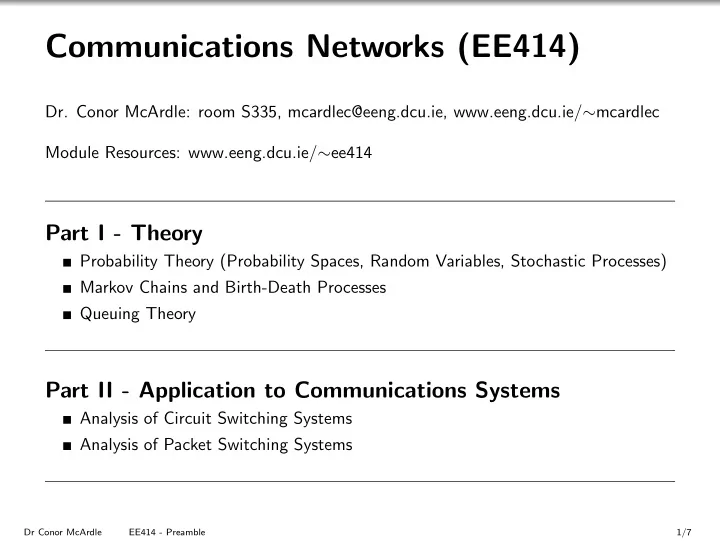

Communications Networks (EE414) Dr. Conor McArdle: room S335, mcardlec@eeng.dcu.ie, www.eeng.dcu.ie/ ∼ mcardlec Module Resources: www.eeng.dcu.ie/ ∼ ee414 Part I - Theory Probability Theory (Probability Spaces, Random Variables, Stochastic Processes) Markov Chains and Birth-Death Processes Queuing Theory Part II - Application to Communications Systems Analysis of Circuit Switching Systems Analysis of Packet Switching Systems Dr Conor McArdle EE414 - Preamble 1/7
Reference Texts Random Processes - A Mathematical Approach for Engineers , Robert Gray and Lee Davisson, Prentice-Hall, 1986. Chapters 1+2 - Background Reading Chapter 3 - Probability Spaces Chapter 4 - Random Variables and Random Processes Queueing Systems Vol. 1 - Theory , Leonard Kleinrock, Wiley, 1975. Chapter 2 - Markov Processes Chapter 3 - Birth-Death Queueing Systems in Equilibrium Chapter 4 - Markovian Queues in Equilibrium Appendices - Probability Reference Performance Analysis of Local Computer Networks , Joseph Hammond and Peter O’Reilly, Addison-Wesley, 1986. Chapter 5 - Background on LANs Chapter 3 - Aloha Chapter 4 - Ring Networks Chapter 4 - Random Access Networks Dr Conor McArdle EE414 - Preamble 2/7
Motivation for Stochastic Analysis Methods Part I of the course provides us with a mathematical ’tool box’ for analysing such systems as shown in examples 1-3 below. Example 1 The figure below shows a large number of customers connected to a telephone exchange. There are many less outgoing trunks than there are customers. Customers make calls randomly and the length of each call (holding time of the trunk) is also random. How many trunks does the telephone company need to provide so that there is only a 1% chance, on average, that a customer is blocked due to all trunks being busy? Local�Loops Trunks Switch (Local�Exchange) Subscribers Dr Conor McArdle EE414 - Preamble 3/7
Motivation for Stochastic Analysis Methods To answer the above question we require: 1 a probabilistic description of when customers attempt calls 2 a probabilistic description of how long calls hold the outgoing trunks (how long calls last) 3 a method of modelling the behaviour of the system, relating it to (1) and (2) 4 and a method of solving the model to deduce the information we require. To do this we need knowledge of probability theory and stochastic analysis methods. Dr Conor McArdle EE414 - Preamble 4/7
Motivation for Stochastic Analysis Methods Example 2 A model of a call centre is shown below. When all operators are busy on calls, new callers are put into a hold queue and wait their turn for connection to an operator. Again, call arrival times and the lengths of calls are random. What fraction of callers wait more than 10 minutes, on average, before an operator answers? Again application of probability theory and stochastic analysis is required to find an answer. Call�Centre Hold�Queue Callers Operators Dr Conor McArdle EE414 - Preamble 5/7
Motivation for Stochastic Analysis Methods Example 3 General communications systems (such as the LAN shown below) are more complex. There may be many queues associated with access to a shared communications medium. The method of accessing the communications medium may be complex. Generally, the more complex system, the less information that may be easily obtained by analysis, however, we can still apply suitable probabilistic methods to gain useful information. For example, we can answer: what is the throughput of the LAN? Workstations�/�Servers Local Area�Network�(e.g.�Ethernet) Dr Conor McArdle EE414 - Preamble 6/7
Motivation for Stochastic Analysis Methods In summary, we are interested in the study of communications systems where the arrival and service processes are random. That is, we cannot predict exactly when a customer or packet will arrive to the system nor can we predict exactly how long any given customer or packet will keep the system busy while it is processed. We wish to determine the performance of such systems mathematically, in terms of measures such as: Utilisation : The fraction of time the system (or communications medium) is busy Throughput : The mean number of customers/packets whose processing is completed (or who are successfully transmitted) in a single time unit. Waiting Time : The time customers/packets spend in the system Queue Length : The number of customers/packets in the system’s queues Blocking Probability : The probability that the system (or communications medium) is fully busy when a customer arrives and there is no remain queuing capacity The mathematical tools we will study form a basis for analysis of many different communications network technologies. Dr Conor McArdle EE414 - Preamble 7/7
Recommend
More recommend